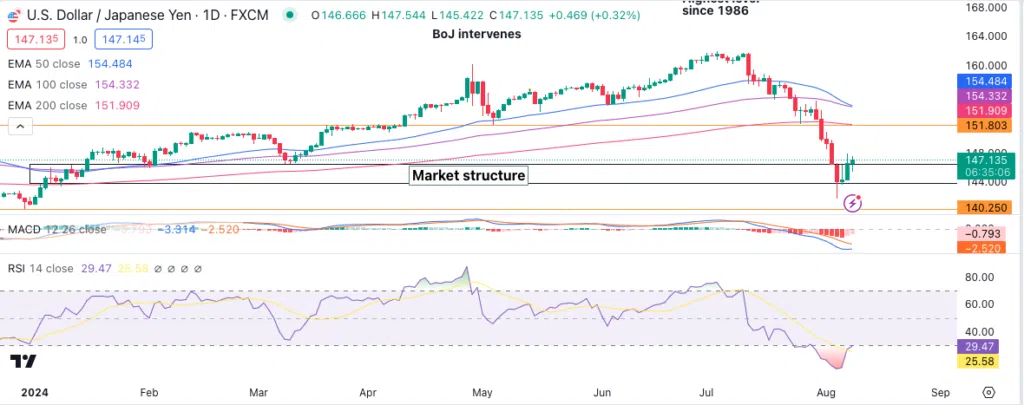-
Best Forex Brokers
Our top-rated Forex brokers
-
Islamic Account Brokers
Best accounts for Muslim traders
-
Brokers for Beginners
Start trading here
-
Forex Demo Accounts
Learn to trade with no risk
-
No-deposit Bonuses
Live trading with no deposit
-
ECN Brokers
Trade with Direct Market Access
-
Lowest Spread Brokers
Raw spreads & low commissions
-
High Leverage Brokers
Extend your buying power
-
Market Maker Brokers
Fixed spreads & instant execution
-
MetaTrader 4 Brokers
Top MT4 brokers in Malaysia
-
MetaTrader 5 Brokers
Top MT5 brokers in Malaysia
-
TradingView Brokers
Top TradingView brokers
-
cTrader Brokers
Top cTrader brokers in Malaysia
-
Forex Trading Apps
Trade on the go from your phone
-
Copytrading Brokers
Copy professional traders
-
All Trading Platforms
Find a platform that works for you
“Some of the moves we’ve seen over the past few days have been historic.”
– Ben Powell, BlackRock Investment Institute
Well, that was fun, wasn’t it? All it takes is one bad NFP, and the markets are thrown into chaos.
Though this isn’t quite true, the markets have been fragile for some time, and the concern that the Federal Reserve can’t manage a ‘soft landing’ for the US economy is long-standing. But – and this will not surprise veteran market-watchers – the roots of this chaos are in Japan.
Let’s rewind to last week, Wednesday, 31st July. Well before the earthquake of Friday’s NFP, the Bank of Japan (BoJ) raised interest rates to 0.25%, the highest since the 2008 financial crisis.
When Wednesday’s interest rate decision hit, the yen had already been falling back from record highs driven by the interest rate differential with the dollar. The USD/JPY continued its sharp downtrend, with the yen strengthening more than 1.7% against the USD over the day. With the Japanese economy showing signs of stress recently, the move led to concern by many market watchers.
“It’s extremely disappointing that the BoJ has chosen to act by ignoring weak economic data. It now looks like it moved to counter the weak yen,” said UBS economist Masamichi Adachi. “The normalisation of Japan’s economy was very precarious to begin with, but the BoJ has made it even more difficult.”
So, the Japanese markets were already nervous when the NFP hit on Friday afternoon. Three weeks ago, the TOPIX (Tokyo Stock Price Index) was at an all-time high, driven by renewed interest in Japanese stocks among international investors. However, the sudden fear of a recession in the United States and the strengthening yen led to a stampede for the exit.
On Monday, August 5th, the TOPIX plummeted 12%, wiping out its gains for the year in its sharpest sell-off since 1987.
The contagion from the massive Japanese sell-off fed into worries over the health of the tech industry and Friday’s NFP data. Markets in the US and Europe opened sharply down. The sell-off became a full-blown panic, with the rout extending far beyond the big tech companies.

With futures traders beginning to price in a surprise August rate cut by the Fed, a 50-basis point cut in September, and the VIX – the so-called “fear index” – spiking to its highest level since the onset of the pandemic, the USD/JPY reversed course.
In an effort to quell the volatility in Japan, on Wednesday 7th July, the BoJ Deputy Governor, Shinichi Uchida made it clear that the central bank would not continue to raise interest rates:
“As we’re seeing sharp volatility in domestic and overseas financial markets, it’s necessary to maintain current levels of monetary easing for the time being… We won’t raise interest rates when financial markets are unstable.”
His remarks had the intended effect, helpfully coinciding with a global rebound from the panicky sell-off, and the USD/JPY climbed 2%.
As we head into the end of the week, it seems as if Monday’s panic was just a bad dream. But the lesson to take from this is twofold. Firstly, markets are very nervous and expect more data-driven volatility over the coming months. Second, don’t be deceived by the sudden calm in the USD/JPY. After years of negative interest rates and unprecedented market intervention, Japan’s efforts to normalise its economy will be painful and more spasms are likely.
Technical Analysis
The USD/JPY sell-off took a breather on Tuesday, August 6th, following a sharp decline since its peak in July. Having rapidly passed all three EMAs (50-EMA, 100-EMA, and 200-EMA) on the way down, price now sits just above a well-tested zone of market structure (between the 144 and 146.5 levels).

Sitting just above 28, the RSI is making its way out of oversold territory, which signals that the last few green days are likely a correction rather than a true price reversal. The MACD line (blue) is also well below the signal line (orange), signalling the potential for further downside moves.
Should the pair extend gains, traders will be eyeing the 148.00 level, and beyond that, the 150.00 psychological handle, and the 151.90 level of the 200-day EMA.
140.25 is the next level of support, which corresponds with the low last seen in December 2023.
Stay updated
This form has double opt in enabled. You will need to confirm your email address before being added to the list.




























